#degasser
Explore tagged Tumblr posts
Text
my wonderful orange cat teddy had to go to the vet unexpectedly yesterday :( but he is back home today and feeling much better :) although he is very very stinky now :|
#he was running a fever and kept vomiting#turns out he was super constipated!!#sorry buddy :( :(#but he responded well to treatment and now no longer has a fever OR constipation#the miracles of modern medicine#I am so grateful to my vet for fitting us in on such short notice#he is so so so stinky now when he usually smells so nice#unfortunately bc I am now 9 (nine) months pregnant this smell is...too much for me to say the least#so he's spending his time with my partner in a different part of the house while he 'degasses'#which is also for the best bc our other cat (lilly) can be so mean to him whenever he comes back from the vet#even when they go together and have their appts together she still hisses at him for days after they come home :(#she's a sensitive little lady and unafraid to make her feelings known..
6 notes
·
View notes
Text

Boost your vacuum system's efficiency with our Mechanical Vacuum Boosters! Designed to optimize performance, these boosters enhance the volume displacement of vapors and gases while keeping power consumption low. Experience high productivity with reduced energy costs – the perfect solution for advanced vacuum applications.
For more details, visit- https://www.acmeairequipments.com/product/mechanical-vacuum-boosters/
#AcmeAirEquipments#MechanicalVacuumBoosters#vacuumboosters#distillation#degassing#Coating#refiningindustrialoil
0 notes
Text
How to keep coffee fresh and aroma by coffee valve?
Do you like to smell the coffee aroma from the coffee valve on a bag of coffee? When we choose a bag of coffee, would you like to smell the coffee aroma from the coffee valve on the coffee bag? I think the answer is: YES! We will choose different kinds of coffee, arabica or robusta… But before we open the bag of coffee, and tasted it. We don’t know how about the quality of that coffee. So…
#Coffee Valve#coffee valve applicator machine#degassing coffee valve#degassing one way valve#degassing valve applicator machine#one way coffee valve#one way degassing coffee valve#one way degassing valve#one way valve
0 notes
Text
youtube
Hydronic Systems | Air & Dirt Separator
0 notes
Text
Degassing Resin Castings with a Pressure Pot
Welcome to the world of perfect resin crafts! Working with resin castings can be tough due to annoying bubbles. Luckily, we have a top-notch solution to make your DIY projects shine - the simple pressure pot.
Many DIY enthusiasts and crafters love using a pressure pot for bubble-free resin pieces. We will reveal how to use a pressure pot to degas resin. Plus, offer tips and tricks for making clear, professional resin work.
#vacuum chamber#silicone molds#resin jewelry#resin curing#resin crafts#resin castings#pressure pot for resin casting#pressure pot for resin#pressure pot#degassing resin#bubble removal
0 notes
Text
Lake Michigan
An AI-penned script for a big budget climate disaster film about the possibility of Lake Michigan cataclysmically degassing causing a limnic eruption. The increasing change in climate causes more and more CO2 to be sequestered in the lake until the lake is forced to belch it all up at once. Most of eastern Wisconsin and western Michigan is suffocated under a massive cloud of carbon dioxide along with Chicago and parts of northeast Illinois and northwest Indiana. Due to the rising ambient temperature, the cloud drifts northward, suffocating much of the Upper Peninsula as well as parts of southern Ontario province. Unfortunately, without actors, the whole film is shot in the director's bathtub as he does all the character voices with knockoff action figures and scale models of towns and cities. The "film" climaxes when the director simulates the resultant tsunami after the mass asphyxiation by dropping several cherry bombs in his tub at once.
#bad idea#movie pitch#pitch and moan#lake michigan#limnic eruption#carbon dioxide#degassing#asphyxia#michigan#wisconsin#illinois#indiana#chicago#ontario#upper peninsula#bathtub#climate change#carbon sequestration#ai#artificial intelligence#writers strike#writers strike 2023#wga#wga strike#wga strong#wga solidarity#sag#sag aftra#sag strike#wga strike 2023
0 notes
Text
Optimizing Filtration Efficiency with Desander Hydrocyclone Filter in the Oil and Gas Industry
Introduction:
The oil and gas industry is constantly evolving, with the demand for efficient and cost-effective filtration solutions becoming increasingly critical. One such solution that has gained prominence in recent years is the desander hydrocyclone filter. This compact and highly efficient filter has proven to be an effective tool in separating solids from liquids in various oil and gas processes. In this blog, we will delve deeper into the desander hydrocyclone filter and its applications in the oil and gas industry, highlighting its benefits and optimization techniques for enhanced filtration efficiency.
What is a Desander Hydrocyclone Filter?
A desander hydrocyclone filter is a type of centrifugal separator that uses the principle of cyclonic separation to remove solid particles from liquids. It typically consists of a conical-shaped chamber with an inlet at the top for the incoming fluid mixture and an outlet at the bottom for the separated solids. As the fluid mixture enters the desander hydrocyclone filter, it is subjected to centrifugal forces, causing the heavier solid particles to move towards the outer wall of the chamber and eventually be discharged through the bottom outlet, while the cleaner fluid is discharged through the top outlet. https://kapwell.co.uk/products/hydrocyclones/desander-hydrocyclone/
Applications in the Oil and Gas Industry:
Desander hydrocyclone filters find extensive applications in the oil and gas industry, where the removal of solid particles from drilling mud, produced water, and other process fluids is crucial for efficient operations. Some of the key applications of desander hydrocyclone filters in the oil and gas industry include:
Drilling Operations: During drilling operations, desander hydrocyclone filters are used to remove drill cuttings, sand, and other solid particles from the drilling mud, ensuring that the mud can be recirculated for optimal drilling performance and reducing wear and tear on drilling equipment.
Produced Water Treatment: In the production of oil and gas, large volumes of water are generated as a byproduct, which needs to be treated before disposal or reuse. Desander hydrocyclone filters are employed in produced water treatment systems to remove solids, such as sand, clay, and other contaminants, ensuring compliance with environmental regulations and protecting downstream equipment.
Refinery Operations: Kapwell Desander hydrocyclone filters are used in refineries to remove catalyst fines, sand, and other solid particles from process fluids, preventing fouling of downstream equipment, such as heat exchangers, pumps, and valves, and optimizing process efficiency.
Benefits of Desander Hydrocyclone Filters:
The use of Kapwell desander hydrocyclone filters in the oil and gas industry offers several benefits, including:
Enhanced Filtration Efficiency: Kapwell Desander hydrocyclone filters are highly efficient in removing solid particles from liquids due to the centrifugal forces generated, resulting in a cleaner fluid stream for downstream processes.
Compact Design: Kapwell Desander hydrocyclone filters are compact in size, making them suitable for installations in space-constrained areas, such as offshore platforms and mobile drilling rigs.
Cost-effective: Kapwell Desander hydrocyclone filters are generally more cost-effective compared to other types of solid-liquid separation equipment, as they do not require filter media replacements, and have low maintenance requirements.
Optimizing Filtration Efficiency: To optimize the filtration efficiency of Kapwell desander hydrocyclone filters in the oil and gas industry, the following techniques can be employed:
Proper Sizing: Selecting the appropriate size of the desander hydrocyclone filter based on the specific application is crucial to achieve optimal filtration efficiency. Factors such as the flow rate, particle size distribution, and desired separation efficiency should be considered during sizing.
Regular Maintenance: Regular inspection and maintenance of desander hydrocyclone filters are essential to ensure optimal performance. This includes cleaning.
Head Office
Provender House, 37 Waterloo Quay, Aberdeen, Scotland, United Kingdom AB11 5BS
[email protected] Phone: +44 01224 007288
0 notes
Text
A bulleted list of some of the silly world building for The Whispered World that has been making us grin in the server (feel free to add on @fourphoenixfeathers @serotoninisheldinkiwis):
Visitors and Intruders are named as such based on behavior, not faction- Visitors are generally polite to neutral, don't cause too much direct or collateral damage, and usually go along with road rules and local law. Intruders tend towards being antagonistic or violent, don't care much about causing damage or will cause damage on purpose, and some go out of their way to purposely flout rules.
All Cybertronians have a distinct scent that they aren't aware of having that gives them away as non-native, a sort of burnt carbon ozone scent from their non-Earth metals degassing in the Earth atmosphere. There's also a distinct faction scent due to different chemical make ups of sanitizing and cleaning materials- Artificial raspberry is Autobots, lemon lime is Decepticons.
All Cybertronians can change their patterning and colors basically at will, but depending on their frame type and dedicated social role, there's certain ranges they are limited to- Ex. Optimus is always pretty bright because as a Prime he's meant to be seen, Ratchet's medic colors are a specific uniform for his role as a medical professional, Bumblebee can change is actual alt pretty drastically but his colors are limited for identification friend v for, etc.
There is a Discord server in universe where people talk about various sightings and there is a section on the server where all the thirsty hoes hang out and gush over the few grainy images of bot and alt forms. We see you planespotter69 and carlover.
Some of the Bots and Cons are aware of and participate in the server. They have no idea other Cybertronians are present.
In universe, humans have nicknames for all the known Visitors, and some humans have befriended the Visitors and their locations become hot spots/neutral zones where both Bots and Cons hang out some times.
There is an in universe YouTube channel where a rando living out in the boontoolies gives free washes to Visitors that let him film them. Their channel is one of the only places where actually clear imagery of the Visitors can be found.
Wheeljack is a fucking gremlin who keeps ransacking junk and scrap yards for parts and he keeps BITING THINGS WHY YOU WEIRDO.
All Cybertronians like to burrow and be close to or under ground, flyers are rare for a reason and they have a whole separate culture compared to ground mechs (this is largely related to how Primus is their planet and the ground is therefore sacred as God's physical body).
There may or may not be a crashed ship buried between the Tigris and Euphrates rivers where a very old, very special artifact crash landed and unwittingly helped shape humanity as it evolved.
38 notes
·
View notes
Text
A quick lil hyperlapse of the degassing process of the silicone for a certain robots custom paw gloves
30 notes
·
View notes
Text
How many kinds of one way coffee valve are produced by Color Suns factory?

View On WordPress
#air valve#cafe valve#coffee degassing valve#Coffee Valve#coffee valve machine#degassing valve#degassing valve applicator#degassing valve applicator machine#manual valve machine#one way valve inserting machine valve applier#one way valve sealing machine#one-way coffee valve#one-way degassing valve#one-way gas valve#Semi-Automatic Valve Applicator Machine#valve applicator machine#valve fixing machine for coffee pouch#valve installer#valve machine
0 notes
Text
Hydronic Systems | Air & Dirt Separator
0 notes
Text
SiliNOT! Testing and Review
Since I run a lot of casting workshops, I've had several people in the costuming/maker community ask me my opinion on SiliNOT!, a relatively new product advertised as a budget- and eco-friendly moldmaking alternative to silicone, urethane, and other single-use materials.
I finally bought a couple of bottles to play with, so I did a test project. My experience and findings are below! (It's not a recipe blog, but if you want to skip the play-by-play and get to the TL;DR, it's under the big "In Summary" header near the bottom.)
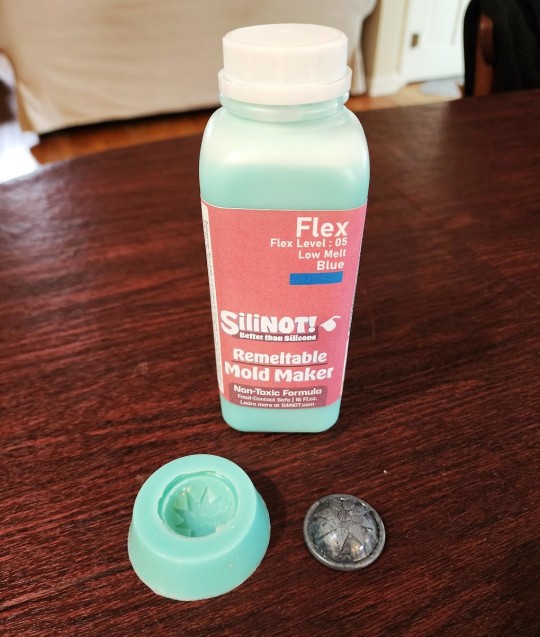
First, if you aren't familiar with this material, SiliNOT! is a remeltable, reusable medium for making molds. Though its exact ingredients are not disclosed, it purports to nontoxic, food-safe, and compostable. It melts in a household microwave or double boiler and solidifies at room temperature (or in a refrigerator/freezer for faster results). The website is https://silinot.com/.
(I am not an affiliate, and have no connection to this company apart from having made one retail purchase from them. I just have a lot of casting experience and like trying out new products.)
The Positive Original
I’m still in the middle of a Vincent Valentine build, so I decided to test the SiliNOT! on his custom buttons. My original is a stack of various nonporous materials: an antique (probably Bakelite) coat button, an epoxy resin dome I cast using a mold I already had in my library, and some engraved Worbla’s Pearly Art for the raised detail. The button shanks won’t be added until the final casting, so the original can be mounted flat for the moldmaking process.
Sample Worbla on the left; completed button stack on the right:
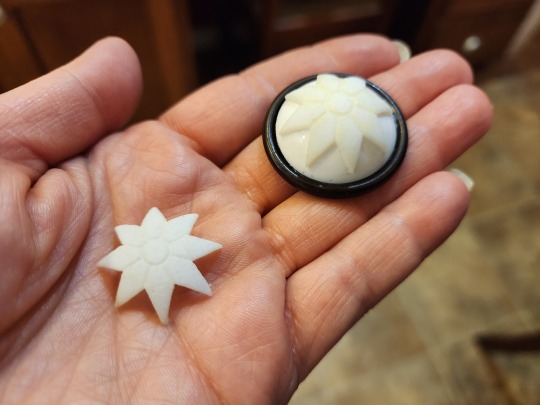
The Mold
I built the mold container the same way I do for silicone pours, with the flat back of the button fixed to a styrene plate and a cylinder (actually a small paper cup with the bottom cut off) surrounding it for the walls. The lip of the cup is sealed all the way around with Monster Clay to prevent leaks.
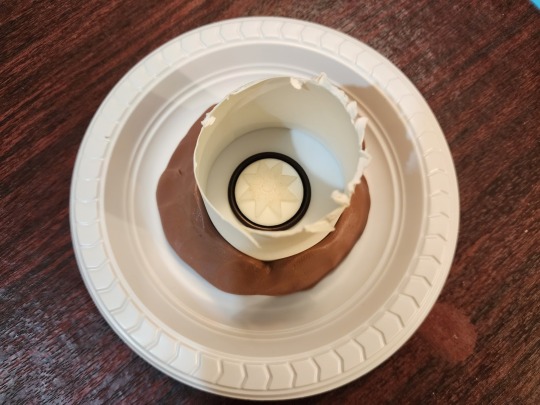
Heating and Pouring
The SiliNOT! didn’t take long at all to heat up; I did maybe four or five 20-second bursts before it was completely fluid. The bottle does get rather warm, so hand protection isn’t a bad idea. If you have heat-resistant gloves, you can use those; I was working in my kitchen (yay for nontoxic stuff!), so I just grabbed an oven mitt with a silicone grip.
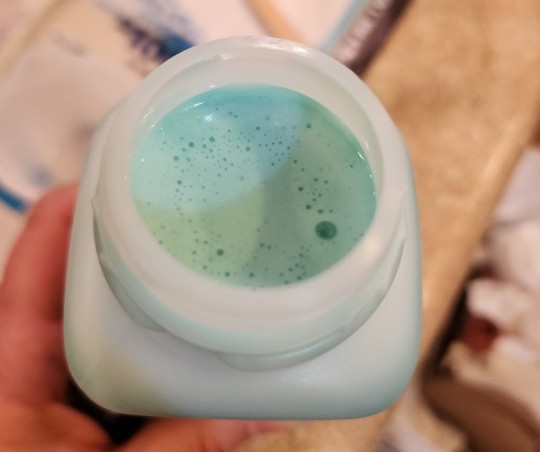
The melted SiliNOT! looks a bit like Luke Skywalker’s blue milk. It’s about the consistency of a yogurt smoothie and likes to pour in a thicker stream compared to silicone. While silicone can be stretched into a thin ribbon for delicate pours or chemically thinned with solvent for really tricky jobs, SiliNOT!'s viscosity is dependent on temperature and never seems to get quite as thin as silicone.
I’d automatically made my mold compact to conserve material (not really a concern with a reusable moldmaking material like SiliNOT!, but after using silicone for more than a decade, I’ve trained myself to be as efficient as possible), so the walls of my mold container were only about half or three quarters of an inch from my object. Because the target was so narrow, I found it difficult to accurately fill from the lowest area of the mold with the SiliNOT! The heavier pour also means more air can get trapped in or under the material.
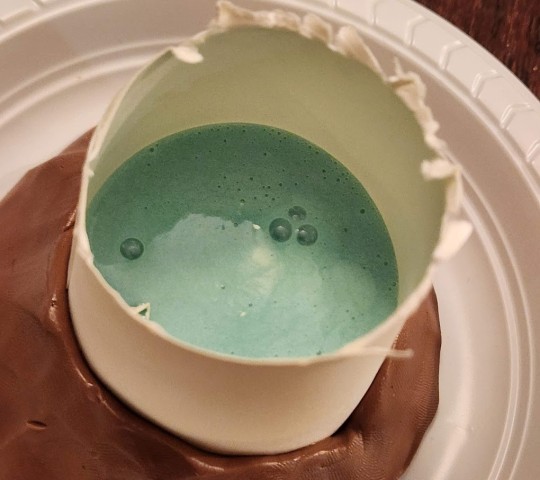
Bubbles are one of the areas in which SiliNOT! is decidedly inferior to silicone. SiliNOT! has higher viscosity, so bubbles don’t want to rise to the surface without vigorous tapping, which can distort the mold edges or affect leveling depending on your mold container. The bubbles that do make their way to the surface are difficult to pop, even when poked with a sharp implement. Heat gun degassing doesn’t have much effect.
Since the bubble surface cools and skins over quickly, I actually had to use a tool and scoop some large bubbles completely out of the mold to allow the surface to level. Critically, the SiliNOT! is opaque, so you can’t spot bubbles clinging to the surface of your original. (This is why my first mold was a reject, and I had to repour. More on that below.)
Hardening
Once the surface had set, I carefully moved the mold into the refrigerator to cool faster. Here’s another area where some types of silicone can have an advantage: I typically use fast-curing Smooth-On products (because I always have random quantities left to use up after our casting workshops), so I rarely have to wait more than half an hour for a silicone mold to cure, regardless of its size or mass.
The SiliNOT! has to chill completely before handling, though, and discharging that amount of heat requires a fair amount of time even in a cool environment. My mold was pretty small, maybe 2 1/2” wide by 1” deep, and it still took around 40 minutes to cool completely. A larger, deeper mold could hold considerably more energy in the center, and might have to be left in the freezer for a couple of hours before use.
Demolding the Original
When the mold was completely chilled, I removed it from the refrigerator and popped it off the plastic plate I’d used for the base of the mold. The texture was very different from what I’d expected: Unlike other meltable materials (Monster Clay, et al.) that have a firm surface when cool, the SiliNOT! remains tacky, which means it promptly collects any debris that crosses its path. In my case, this meant I had to pick dog hair off the surface throughout the casting process (and I don’t want to think about what would happen if glitter had contaminated the work space).

I’d used a paper cup for my mold walls, which usually works fine with fast-curing silicone. But the SiliNOT! must have a high oil content, because the cup absorbed some of it:
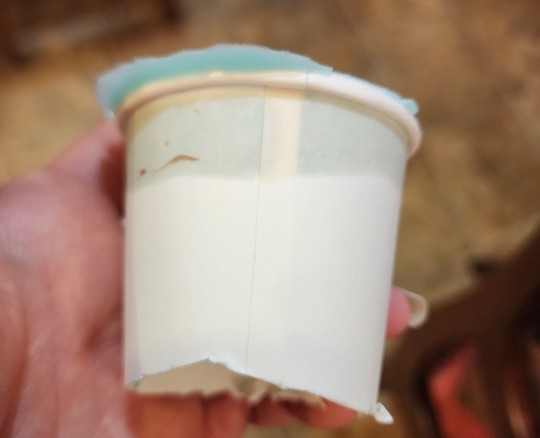
Lesson learned; use only nonporous containers with this stuff.
The SiliNOT!! really wanted to cling to the edges of my original, so I had to go slow at first to avoid tearing the thin flanges of the mold off. However, it did demold nicely from the smooth surfaces, and preserved texture very well. You can see the Worbla pebbling and the engraving channels clearly in the mold (as well as some dust and dog hair, because I made the mistake of setting it down briefly):
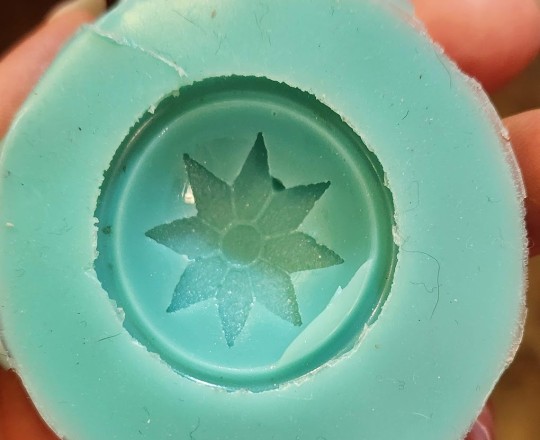
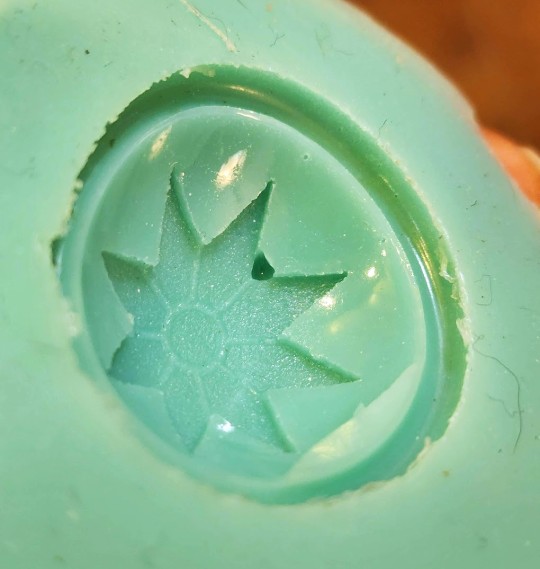
Unfortunately, as you can see, a large bubble had stuck to my original and created a pit in the mold, so I decided to do a second mold pour. I figured I’d tear up the failed mold and put the pieces back in the bottle to remelt… and discovered I couldn’t. The mold would stretch and twist, but not tear. It also seemed to return to its original shape relatively faithfully. Here’s a video of me manhandling the mold:
As you can see, the SiliNOT! has much better stretch and recovery than many silicone products (there are silicones that stretch well -- some of the Dragon Skin products come to mind -- but they’re not typically marketed for moldmaking). This means it’s likely well suited to casting objects with moderate undercuts or oddly-shaped bits that need the mold to stretch during demolding.
You can cut the SiliNOT! easily with scissors, which is the recommended method for getting it back in the bottle when you’re ready to remelt.
Take Two
Using what I’d learned from the first pour, I did the second one inside a hard plastic ramekin. This gave me a bit more room to pour into the floor of the mold, reducing the bubble risk, and also eliminated the porous paper cup that had absorbed oil. I still had the issue with bubbles that didn’t want to pop, but there were fewer of them this time.

The ramekin made for a much cleaner mold, buuuuut there was ANOTHER BUBBLE right in the middle of the design. >.<
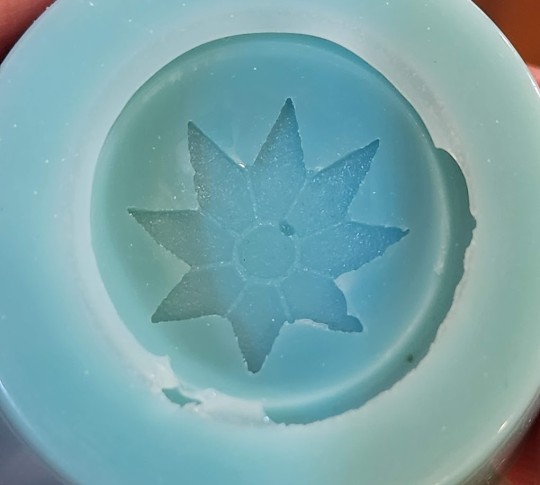
Take Three
Lather, rinse, repeat. Or in this case, melt, pour, chill.
This time I heated the SiliNOT! as much as I dared and did the absolute slowest, narrowest pour I could manage, giving the air extra time to escape as the mold was filled from the bottom. The risk with stringing out the pour like this is that in a thinner stream, the heat escapes faster, leading to uneven viscosity as the liquid fills the mold. I don’t think that’s a major problem for this particular piece, but it’s something to pay attention to as regards leveling and degassing, especially for larger molds that will take longer to fill.
The result of pour three:
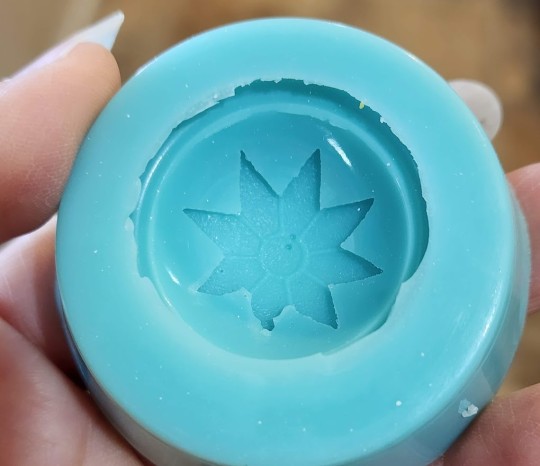
/siiiiigh/ Well, at least the bubbles are smaller, this time. They may not show up enough to matter in the final cast. I’ll give it a try.
Casting
I had leftover workshop resin that was getting on toward the end of its shelf life, so I used Smooth-On Smooth-Cast 300 for my initial resin trial. It’s an opaque white resin with about a 10-minute cure time (the fast turnaround is why we use it for workshops).
Before pouring, I had to do a little mold cleanup where the SiliNOT! had managed to sneak under the edge of the Worbla (I think I’d loosened the corner of the star from prying it out of so many molds), but since the SiliNOT! stretches so well, it was pretty easy to invert it to get little scissors down into the bottom of the depression.
For the first cast, I didn’t use anything but the resin in order to get a baseline. Ideally I’d like to cold cast or dye the resin so I don’t have to worry about paint chipping, but since I’m doing a trial here (and need multiple buttons anyway) I figured some plain white extras wouldn’t hurt.
So, my first cast…

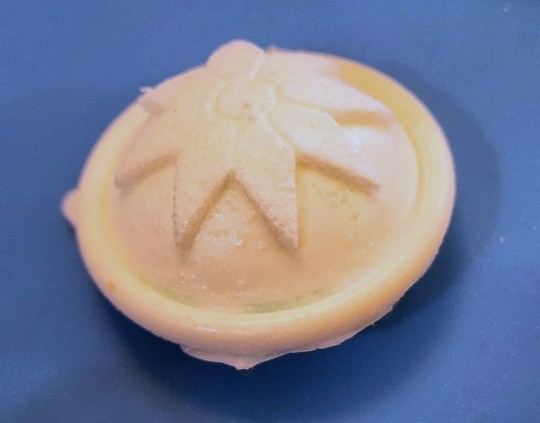
…smacked into a big problem, which I probably should have seen coming: The resin I’m using is a fast cure formula, which means it discharges a fair amount of heat as it's going through that rapid chemical reaction -- enough heat to melt the SiliNOT!, as it turned out. When I tried to demold it (after giving it a few extra minutes beyond label time to be sure it was done), the surface of the mold had melted to the resin and even embedded itself in a few places. It’s difficult to see the resin detail in the photos (my camera went into white balance panic mode with all the shades of white and blue), but you can see how pitted the formerly-smooth mold surface is.
In fairness to the SiliNOT!, the bottle does say that you should put the mold in the freezer for half an hour before casting high-temperature materials. But I assumed high-temperature material was something like candle wax or melted chocolate, rather than ordinary resin. (And the mold had just come out of the refrigerator.)
So, on to pour FOUR of the SiliNOT! mold…
Take Four
NGL, this is getting a little old. >.<
Fourth mold definitely needed some cleanup around the edges, and there are still a couple of tiny bubbles I can’t seem to get rid of, but it’s good enough for a test. (I’m starting to despair of using these for actual production, given how many times I’ve had to redo the molds because of bubbles...)

Deep in the recesses of my basement, I found some transparent epoxy resin with a 24-hour cure time -- much slower and lower-temperature than the Smooth-Cast. Since it cures clear, I went ahead and mixed in some metallic powder pigment on the off chance that I get a usable button out of this one. I had excess resin after mixing, so I poured that into my first mold, which has a bubble in the design but is otherwise fine. Two test pieces are better than one, right?
Results
Here are the results of the slow-curing resin out of mold #4:
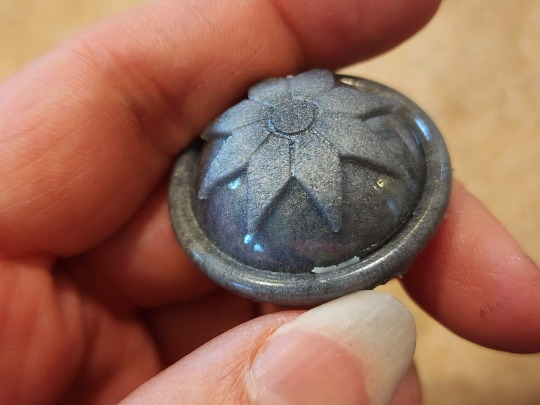
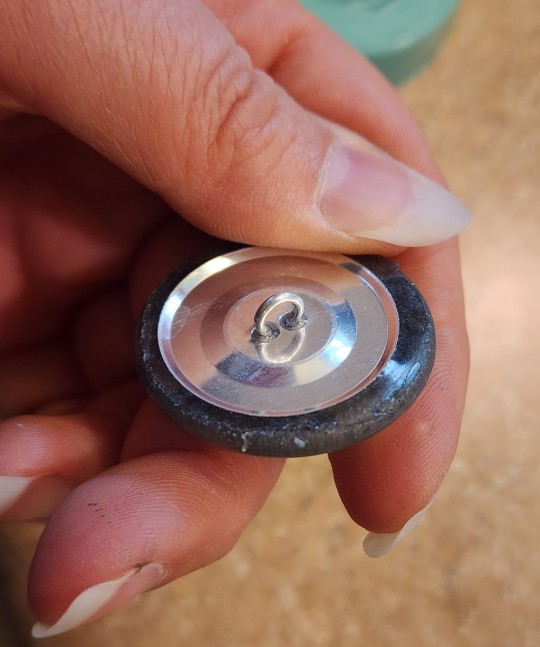
Finally, a (mostly) clean cast!
As you can see, the detail reproduction is excellent -- certainly on par with the pulls from the silicone mold I ended up making while waiting on this set to cure (purely for time reasons; I couldn’t afford five days to cast the buttons using slow-curing resin, and with a silicone mold and fast-curing resin I could get them all done within a couple of hours).
However, you can also see a few spots where bits of the SiliNOT! embedded themselves in the final cast. Part of that may be due to design flaw in the original; I didn’t want to glue anything permanently to the antique button, and that resulted in a tiny gap between the button and the resin hemisphere. Silicone has enough strength to resist tearing out in that kind of area, but apparently the SiliNOT! doesn’t. The bits of mold around the outer edge seem to have stuck just to be difficult, as there was no structural reason for those to have become embedded in the resin. This means the mold could be damaged by successive casts, reducing its usable life and accuracy.
Still, the mold definitely produced decent results for a first cast, and a different shape might not have had as much of a problem with tearing off mold parts. The slow-curing resin is a bit of a limitation, but not a unique one (I use this same epoxy resin for any glass-clear casts I do, and only use the Smooth-Cast 300 for opaque items or things I need very quickly). I don’t personally use UV resin, but I’d be curious to learn how it performs with the SiliNOT!
IN SUMMARY:
Here’s the TL;DR on SiliNOT!
Pros
Cost effectiveness. This is the most obvious advantage of SiliNOT! over silicone; it’s (theoretically) infinitely reusable, and even with natural attrition/inevitable contamination from use, you can likely get over a hundred pours out of a bottle. That's a lot cheaper per use than silicone.
Non-toxicity. SiliNOT! is touted as food contact-safe, so you don’t have to panic if you get it on your skin or kitchen counters. While platinum-cure silicone is also relatively harmless (some varieties are labeled for food or life casting), other common moldmaking materials such as tin-cure silicone or urethane are not. (NOTE: Since the company is very hush-hush about what actually makes up the SiliNOT! secret formula, I do not know if it might release any vapors or fumes that would be irritating or harmful to pet birds. In general, I advise not doing any kind of casting around birds.)
Eco-friendliness. This is the biggest draw for me personally: Given the number of casting workshops I run and all the things I sell commercially, I have constant guilt about the amount of waste I generate for creative projects. In most areas of life I’m an aggressive reduce/reuse/recycler and try to use organic materials instead of synthetics whenever possible, so a mold that’s reusable and compostable is very appealing.
Ease of use. It’s honestly pretty hard to mess this up -- just microwave according to the directions and pour. No measuring, no A/B mixture, no concerns about chemical contamination from latex or sulfur, etc.
Shelf life. Unlike silicones, which have a shelf life of anywhere from six months to three years depending on storage conditions, the SiliNOT! purports to be shelf-stable. It's compostable, so don’t bury it in your yard, but otherwise it appears that it could be kept on hand for years.
Cons
Bubbles. Honestly the most irritating thing about this stuff for me. I’m used to being able to see bubbles forming as I pour, tap them to the surface, and remove them. The fact that I poured four molds of the same object and never once got one without bubbles is super irritating.
Stickiness. I’m not a big fan of the tacky surface texture, and while I haven’t done any cold casting yet, I can imagine that it would be very difficult to clean out any pigment or mica powder that got where you didn’t want it. I probably wouldn’t use this for any kind of cold casting that required isolated colored areas or changing colors between casts.
Set time. The SiliNOT! may take longer to cool than a fast silicone would to cure when dealing with larger molds, so it’s not ideal for projects with a really tight turnaround. (But cosplayers would never be casting something the night before a con, right? We always plan ahead and never, ever procrastinate!)
Library life. The SiliNOT! may or may not structurally degrade over time the way urethane, latex, and tin cure silicones do, but I noticed even in my very limited casts that it was prone to having tiny bits of the mold (particularly at edges) stick and pull off. While I keep most of my platinum silicone molds for years and reuse them, I don’t feel that the SiliNOT! molds would hold up to repeated casting, and they’re far more sensitive to ambient temperature, so they’re probably best used for short term only. (I also wonder about the possibility of oil leaching out in long-term storage.)
Comparative Ranking
Ranking it against other mold-making materials, I’d place SiliNOT! below platinum-cure silicone in terms of performance, but maybe somewhere in the neighborhood of urethane and tin-cure silicone. It's definitely superior to latex. (Though to be honest, I'd rank Play-Doh above latex. I hate working with that stuff.)
Factoring in cost and environmental impact, it beats out urethane and tin-cure silicone. I'm still not sure if I'd rank it above platinum-cure silicone, though... Silicone costs much more and isn't eco-friendly, but the performance and lifespan is significantly better, so it still makes more sense for some projects.
Alginate is another type of material entirely, but in some ways SiliNOT! is comparable to it -- both are more cost-effective than silicone, both are biodegradable, both are skin safe, and both have long shelf lives. But SiliNOT! is easier to use for beginners than alginate, which has to be mixed to the right consistency and has an extremely short lifespan once poured.
Overall, I would recommend SiliNOT! for:
People who want accurate, non-shrinking molds but don’t have the budget for platinum-cure silicone
People who are committed to eliminating waste from single-use materials, and are willing to trade off a little performance for a more eco-friendly material
Projects with smooth surfaces and no indentations/sharp edges/undercuts where bubbles might stick (e.g. cabochons; simple geometric forms)
Projects where you need only one or two casts of something, rather than many casts from the same mold
Casting oddly-shaped pieces around which the mold needs to stretch in order to demold
Use with slow-curing resins that do not generate much heat
I would NOT recommend SiliNOT! for:
Extremely complex or detailed pieces, or pieces with a lot of surface texture that bubbles might stick to
Two-part molds
Projects requiring many identical casts out of the same mold
Molds that you intend to add to your library for future or repeat casting
Use with fast-curing resins, melted wax, melted Monster Clay, or any other material that emits heat
Cold casting with precise color application
My Overall Opinion
It's... okay? I will almost certainly keep SiliNOT! in my toolkit for certain specific applications. It's MUCH cheaper over the long term, I love the idea of recycling mold material, and there are some projects for which it will likely perform very well (those listed in the above bullet points). I will also admit that three days of working with it does not constitute a comprehensive familiarity with the product, and it might be the sort of thing that you get better at working with after more practice. (Just learning how to eliminate bubbles would go a long way toward making me adopt this for more projects!)
However, I don't quite buy the "better than silicone" tagline. It's definitely more difficult to get a perfect result, and there are some projects for which platinum-cure silicone is always going to be more reliable (e.g. high-temperature casting, mass production, large-scale life casting).
For those looking for a recommendation of whether or not to buy, I'd say look at your project budget and the applications for which you're going to be making molds, and let those factors guide which mold material you go with. People doing some kinds of projects are likely going to find this a godsend, while those doing different projects would probably hate working with it.
37 notes
·
View notes
Text
my mother makes sex toys (a fact she shares proudly), so she says im allowed to use her Silicone Cock Degassing Tank for my furby beak tests if i come visit. W
18 notes
·
View notes
Text

she fights, bites, and isn’t allowed on flights its peni (penicillin) and she is almost EIGHT MONTHS OLD but is spiritually much older they use any pronouns and love eating grasshoppers mainly for the sport. she believes in tarot cards but NOT astrology and HATES Neal degass Tyson
#furby community#long furby#my furby#furby fandom#safe furby#custom furby#furby#furby lore#furby oddbody
102 notes
·
View notes
Text
🚀 Dinostar Aluminium Ingots: Leading Innovation in Aluminium Ingots🚀

Dinostar Aluminium (brand of Ngoc Diep Aluminium JSC) cements its status as Vietnam's top aluminium solution provider with the launch of a premium ingot line. Catering to industries such as aerospace, automotive, electronics, high-tech manufacturing, and household appliances, Dinostar’s aluminium ingots are designed to deliver unmatched performance, durability, and reliability for a wide range of applications. ⚙️ A Wide Range of Aluminium Ingots Dinostar offers an extensive variety of high-quality aluminium ingots to meet diverse industrial requirements: - Standard alloys such as ADC12, ADC6, ADC3, ADC-SH, A360, A380, A390 (YD155), A413, AC2B, and AC4C. - Silicon-containing aluminium alloy options, including AlSi9, AlSi10Fe, AlSi15, and AlSi20, tailored to stringent industrial demands. - Degassed aluminium products, ideal for steel production and metallurgy, enhancing efficiency and purity in the production process. - Popular 6063 and 6061 aluminium ingots, known for their versatility and high performance in various applications. ⚙️ Quality Standards: Dinostar Aluminium Ingots are manufactured with advanced technology and adhere to strict Japanese-standard production processes. This ensures the highest level of quality, meeting even the most demanding industry standards. Key Applications Include: - Steel and Metallurgy: Optimized for enhancing the efficiency of steel production. - Casting and Fabrication: Perfect for crafting consumer goods, industrial equipment, and high-precision components. - Specialized Industrial Applications: Designed for sectors requiring top-tier materials with outstanding durability and reliability. ⚙️ Commitment to Excellence As a trusted partner in comprehensive aluminium solutions, Dinostar Aluminium continues to innovate and expand its product offerings. With a relentless focus on quality and customer satisfaction, Dinostar is dedicated to delivering premium alloy ingots that meet both domestic and international standards. Partner with us to access aluminium ingots engineered for excellence.. Explore how we can help elevate your projects and industries to new heights! 🤝 Get in touch with Dinostar Aluminium to learn more.
2 notes
·
View notes
Text
Understanding the Desander Hydrocyclone Filter in the Oil and Gas Industry
The oil and gas industry relies on various equipment and technologies to extract, process, and transport hydrocarbons. One crucial piece of equipment used in this industry is the desander hydrocyclone filter, which plays a critical role in separating solid particles from liquids. In this blog post, we will delve into the details of the desander hydrocyclone filter, its working principle, applications, and benefits in the oil and gas industry.
Introduction to Kapwell Desander Hydrocyclone Filter
Kapwell desander hydrocyclone filter is a mechanical device that uses centrifugal force to separate solid particles from fluids, such as water, oil, and gas. It is widely used in the oil and gas industry to remove sand, silt, and other solid particles from drilling mud, produced water, and other process fluids. The desander hydrocyclone filter is typically installed upstream of other processing equipment, such as separators and pumps, to protect them from damage caused by abrasive particles.
Working Principle of Desander Hydrocyclone Filter
Kapwell desander hydrocyclone filter operates based on the principle of centrifugal force. It consists of a cylindrical body with a conical bottom and an inlet at the top for the fluid to enter. The fluid enters the hydrocyclone tangentially, creating a swirling motion inside the device. As the fluid swirls, the centrifugal force pushes the solid particles towards the walls of the hydrocyclone, causing them to settle and collect at the bottom of the conical section. The cleaned fluid then exits through the apex at the bottom of the hydrocyclone and is discharged for further processing. https://kapwell.co.uk/products/hydrocyclones/desander-hydrocyclone/
Applications of Desander Hydrocyclone Filter
Kapwell desander hydrocyclone filter finds wide-ranging applications in the oil and gas industry. Some of its common applications include:
Drilling Operations: During drilling operations, the desander hydrocyclone filter is used to remove sand, silt, and other solid particles from drilling mud to prevent wear and tear of drilling equipment, improve drilling efficiency, and maintain wellbore stability.
Produced Water Treatment: Produced water is a by-product of oil and gas production and often contains solid particles that need to be removed before discharge or reuse. The desander hydrocyclone filter is used to efficiently remove these solid particles from produced water, meeting environmental regulations and minimizing the environmental impact of produced water disposal.
Oil and Gas Processing: The desander hydrocyclone filter is used in various stages of oil and gas processing to remove sand, clay, and other solid particles from crude oil, natural gas, and other process fluids. This helps to prevent equipment fouling, reduce maintenance costs, and improve the quality of the end product.
Benefits of Desander Hydrocyclone Filter
The desander hydrocyclone filter offers several benefits in the oil and gas industry, including:
Efficient Particle Separation: The desander hydrocyclone filter is highly efficient in separating solid particles from fluids due to its unique design and working principle. It can remove particles down to a few microns in size, ensuring high-quality filtration.
Compact Design: The desander hydrocyclone filter has a compact design, which makes it suitable for installation in limited space environments, such as offshore platforms and drilling rigs.
Low Maintenance: The desander hydrocyclone filter has no moving parts, resulting in low maintenance requirements and reduced downtime, which is crucial in the demanding and time-sensitive oil and gas industry.
Cost-effective: The desander hydrocyclone filter is cost-effective compared to other solid-liquid separation technologies, as it does not require filter media replacement, and its simple design reduces capital and operational costs.
Head Office
Provender House, 37 Waterloo Quay, Aberdeen, Scotland, United Kingdom AB11 5BS
[email protected] Phone: +44 01224 007288
0 notes